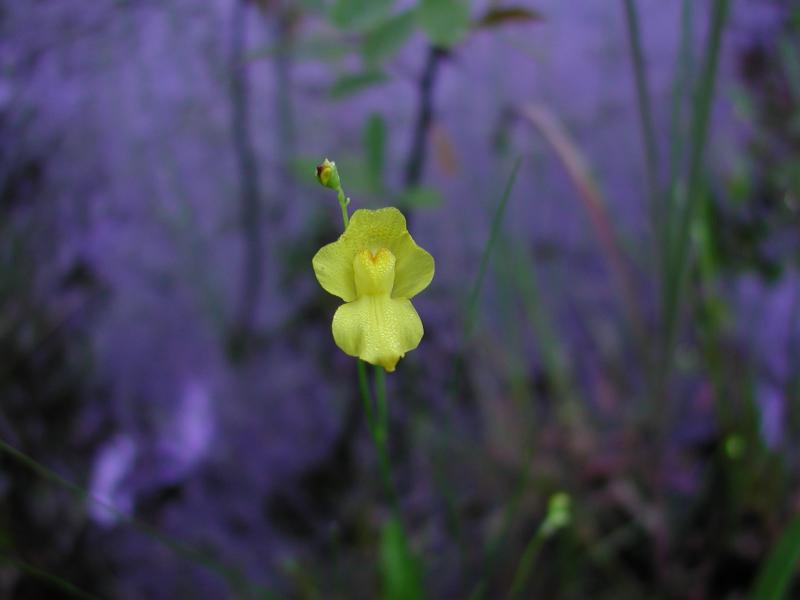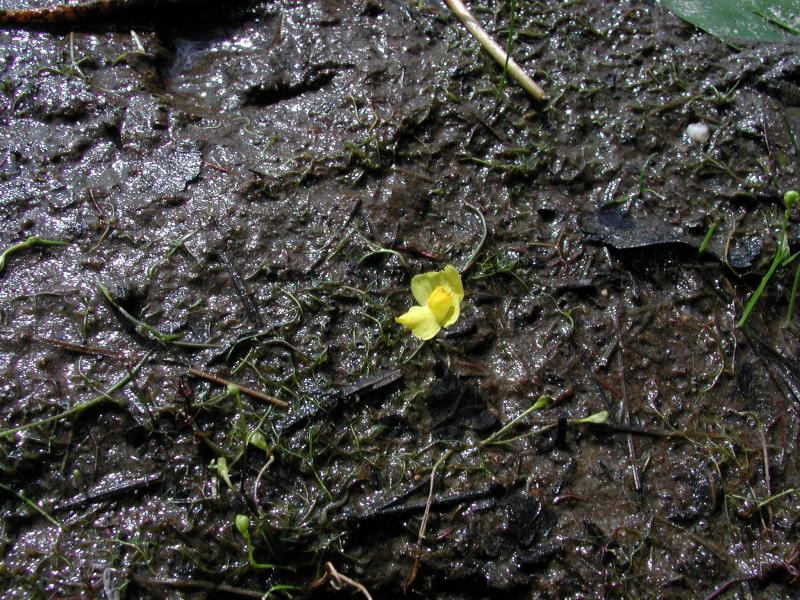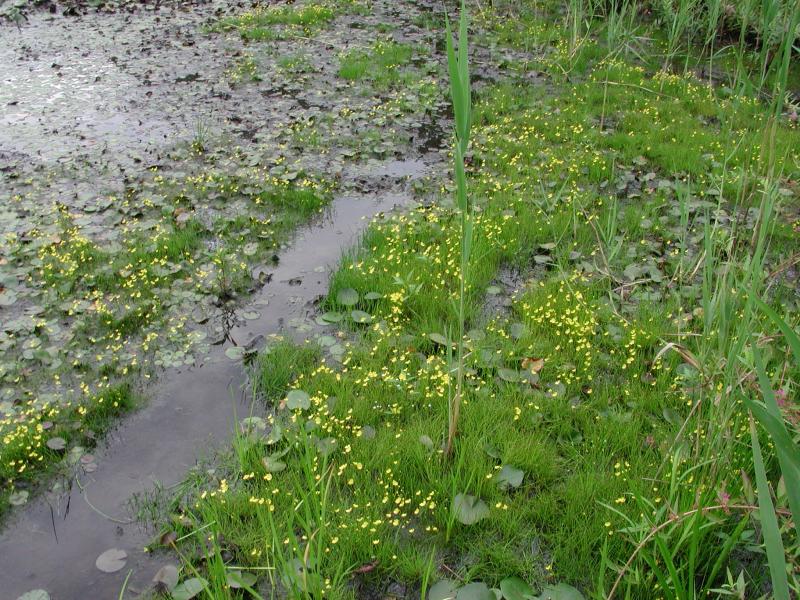Striped Bladderwort
Utricularia striata LeConte ex Torrey
- Class
- Dicotyledoneae (Dicots)
- Family
- Lentibulariaceae (Bladderwort Family)
- State Protection
- Threatened
Listed as Threatened by New York State: likely to become Endangered in the foreseeable future. For animals, taking, importation, transportation, or possession is prohibited, except under license or permit. For plants, removal or damage without the consent of the landowner is prohibited.
- Federal Protection
- Not Listed
- State Conservation Status Rank
- S2
Imperiled in New York - Very vulnerable to disappearing from New York due to rarity or other factors; typically 6 to 20 populations or locations in New York, very few individuals, very restricted range, few remaining acres (or miles of stream), and/or steep declines.
- Global Conservation Status Rank
- G4G5
Apparently or Demonstrably Secure globally - Uncommon to common in the world, but not rare; usually widespread, but may be rare in some parts of its range; possibly some cause for long-term concern due to declines or other factors. More information is needed to assign either G4 or G5.
Summary
Did you know?
Some organisms like Euglena and some diatoms are able to survive and reproduce within the bladders of bladderworts without being digested. The movement of the bladder trapdoors to catch prey is the most rapid movement known among plants but its exact mechanism is still a mystery. This species is relatively easy to grow in the greenhouse (Schnell 2002).
State Ranking Justification
There are eight existing populations and two of them consist of multiple, hydrologically connected ponds. There are five populations from the late 1800s and early 1900s which have not been resurveyed.
Short-term Trends
The short-term trends appear stable. Most populations have been surveyed at least twice. More surveys at shorter intervals may yield more precise short-term trends.
Long-term Trends
The long-term trend appears stable. This plant has always been very rare in New York and there have been about the same number of populations over the last 100 years. Relatively new threats such as Phragmites may reduce populations in the future.
Conservation and Management
Threats
Some ponds have impacts from shoreline development which threaten populations with direct disturbance by trampling and ATV use. The invasion of Phragmites is also a threat to a few populations.
Conservation Strategies and Management Practices
The pondshores need to be protected from direct disturbance by ATVs and excessive trampling. Exotic invasive species must be prevented from colonizing the shores and any existing populations must be eliminated. A natural buffer of at least 200 feet should be established around the ponds to prevent excessive runoff and pollution events.
Research Needs
Research is needed about habitat preference and seed banking in order to augment existing populations.
Habitat
Habitat
This bladderwort almost always occurs on coastal plain pondshores although it has been seen in a sedge meadow with Sphagnum and a sandy wet powerline right-of-way through pine barrens (New York Natural Heritage Program 2012). Shallow ponds on the coastal plain (Gleason and Cronquist 1991). Bog waters, marshes, and ditches on the coastal plain (Schnell 2002).
Associated Ecological Communities
- Coastal plain pond shore
(guide)
The gently sloping shore of a coastal plain pond with seasonally and annually fluctuating water levels. Plants growing on the pond shore vary with water levels. In dry years when water levels are low there is often a dense growth of annual sedges, grasses, and herbs. Submerged and floating-leaved aquatic plants, such as fragrant waterlily and pondweeds, may become "stranded" on the exposed shore. In wet years when the water level is high only a few emergents and floating-leaved aquatics may be noticeable. T
- Pine barrens shrub swamp
(guide)
A shrub-dominated wetland that occurs in shallow depressions in the coastal plain, often as the transition zone between a coastal plain pond shore and either pitch pine-scrub oak barrens or pitch pine-oak forest.
Associated Species
- Brasenia schreberi (water-shield)
- Carex striata (Walter's sedge)
- Chamaedaphne calyculata (leatherleaf)
- Clethra alnifolia (coastal sweet-pepperbush)
- Drosera filiformis (thread-leaved sundew)
- Drosera intermedia (spatulate-leaved sundew)
- Eleocharis flavescens var. olivacea (olive-fruited spike-rush)
- Eleocharis robbinsii (Robbins's spike-rush)
- Eriophorum virginicum (tawny cotton-grass)
- Eupatorium pilosum (ragged thoroughwort)
- Euthamia caroliniana (slender flat-topped-goldenrod)
- Fimbristylis autumnalis (autumn fimbry)
- Gaylussacia baccata (black huckleberry)
- Gaylussacia dumosa
- Gaylussacia frondosa (dangleberry)
- Gratiola aurea (golden hedge-hyssop)
- Ilex glabra (inkberry)
- Juncus canadensis (Canada rush)
- Juncus militaris (bayonet rush)
- Kalmia angustifolia
- Lyonia ligustrina
- Myrica gale (sweet gale)
- Myrica pensylvanica
- Nymphaea odorata
- Osmunda cinnamomea
- Platanthera blephariglottis
- Rhexia virginica (Virginia meadow-beauty)
- Rhynchospora alba (white beak sedge)
- Rhynchospora inundata (horned beak sedge)
- Rhynchospora macrostachya (tall horned beak sedge)
- Sarracenia purpurea (purple pitcherplant)
- Schoenoplectus americanus (chair-maker's bulrush)
- Scirpus cyperinus (common wool-grass)
- Vaccinium corymbosum (highbush blueberry)
- Viola lanceolata (lance-leaved violet)
Range
New York State Distribution
This small carnivorous plant is currently known only from Suffolk County, Long Island, is with historical records to the west in Nassau County.
Global Distribution
This carnivorous plant occurs from Long Island south along the Atlantic Coastal Plain to northern Florida and west along the Gulf Coast from the panhandle of Florida to East Texas.
Identification Comments
General Description
Fibrous bladderwort is an aquatic species of shallow water. Stolons with a large number of traps penetrate the sandy or silty bottoms of ponds or ditches. Above them in the water is a single whorl of stolons (small foxtail) 5-10 cm long and up to 4 cm wide with very fine branches. The peduncle is 10-40 cm long and fairly stout at 2 mm wide. There are 2-6 long-pedicelled, bright yellow flowers that are 2 cm long with the upper lip as long as or longer than the lower lip and weakly 3-lobed. The spur is about as long as the lower lip or slightly exceeds it (Schnell 2002).
Identifying Characteristics
NOT ALL LEAVES HAVE BLADDERS
Best Life Stage for Proper Identification
This bladderwort can only be identified in flower.
Similar Species
Utricularia gibba is the most closely related species but it has no foxtails, a smaller peduncle, 5-10 cm and only 1 mm wide, and smaller flowers about 1 cm long (Schnell 2002).
Best Time to See
The best time to identify this plant is July through September.
- Flowering
The time of year you would expect to find Striped Bladderwort flowering in New York.
Striped Bladderwort Images
Taxonomy
Striped Bladderwort
Utricularia striata LeConte ex Torrey
- Kingdom Plantae
- Phylum Anthophyta
- Class Dicotyledoneae
(Dicots)
- Order Scrophulariales
- Family Lentibulariaceae (Bladderwort Family)
- Order Scrophulariales
- Class Dicotyledoneae
(Dicots)
- Phylum Anthophyta
Additional Common Names
- Fibrous Bladderwort
Synonyms
- Utricularia fibrosa Walt.
Additional Resources
Best Identification Reference
Crow, Garrett E. and C. Barre Hellquist. 2000. Aquatic and Wetland Plants of Northeastern North America: A revised and enlarged edition of Norman C. Fassett's a Manual of Aquatic Plants. Volume One: Pteridophytes, Gymnosperms, and Angiosperms: Dicotyledons. The University of Wisconsin Press. Madison, Wisconsin. 536 Pages.
Other References
Fernald, M.L. 1950. Gray's manual of botany. 8th edition. D. Van Nostrand, New York. 1632 pp.
Gleason, Henry A. and A. Cronquist. 1991. Manual of Vascular Plants of Northeastern United States and Adjacent Canada. The New York Botanical Garden, Bronx, New York. 910 pp.
Holmgren, Noel. 1998. The Illustrated Companion to Gleason and Cronquist's Manual. Illustrations of the Vascular Plants of Northeastern United States and Adjacent Canada. The New York Botanical Garden, Bronx, New York.
House, Homer D. 1924. Annotated list of the ferns and flowering plants of New York State. New York State Museum Bulletin 254:1-758.
Mitchell, Richard S. and Gordon C. Tucker. 1997. Revised Checklist of New York State Plants. Contributions to a Flora of New York State. Checklist IV. Bulletin No. 490. New York State Museum. Albany, NY. 400 pp.
New York Natural Heritage Program. 2010. Biotics database. New York Natural Heritage Program. New York State Department of Environmental Conservation. Albany, NY.
New York Natural Heritage Program. 2024. New York Natural Heritage Program Databases. Albany, NY.
Ogden, E.C. 1974. Anatomical patterns of some aquatic vascular plants of New York. New York State Museum Bull. 424.
Schnell, Donald E. 2002. Carnivorous Plants of the United States and Canada. Second edition. Timber Press, Portland, Oregon.
Seymour, F.C. 1982. The flora of New England. A manual for the identification of all vascular plants including ferns and fern allies growing without cultivation in New England. Moldenka, Plainfield, New Jersey.
Taylor, Norman. 1915. Flora of the vicinity of New York. Memoirs of the New York Botanical Garden vol. V. New York, NY.
Uttal, L.J. 1956. Notes on Utricularia biflora and Utricularia fibrosa. Rhodora 58:41-43.
Weldy, T. and D. Werier. 2010. New York flora atlas. [S.M. Landry, K.N. Campbell, and L.D. Mabe (original application development), Florida Center for Community Design and Research http://www.fccdr.usf.edu/. University of South Florida http://www.usf.edu/]. New York Flora Association http://newyork.plantatlas.usf.edu/, Albany, New York
Links
About This Guide
This guide was authored by: Stephen M. Young
Information for this guide was last updated on: September 6, 2012
Please cite this page as:
New York Natural Heritage Program. 2024.
Online Conservation Guide for
Utricularia striata.
Available from: https://guides.nynhp.org/fibrous-bladderwort/.
Accessed July 27, 2024.


